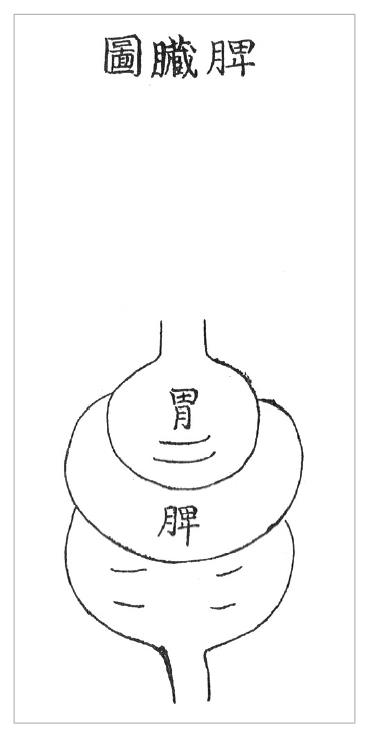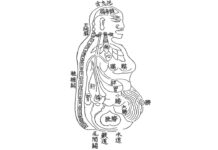Written By Jun Heo(許浚, 1539~1615), Translated by Namil Kim, Wung Seok Cha et al., Published by Ministry of Health & Welfare (Korea)
01 The Shape of the Spleen 脾形象 비의 형상
- ① The shape of the spleen resembles a horse’s hoof. It inwardly covers the gastric cavity. It emulates the shape of soil. Meridian qi accumulates in the center and emits profound qi. This is where thought stays.
- ②The shape of the spleen is flat and resembles a horseshoe or scythe.
- ③ The weight of the spleen is about 2 geun 3 nyang. Its width is 3 chon, and length is 5 chon. The dispersed fluid around the spleen amounts to about 0.5 geun. It houses blood and warms the five viscera. It governs the storing of ideation.
- ④ The spleen means to help. Located under the stomach, it helps stomach qi in digesting food and water. The stomach mainly receives food and the spleen mainly digests food.
02 Areas of the Spleen 脾部位 비의 부위
- ① The length of the spleen is 1 ja and it covers the huge storage. The huge storage is the upper entrance of the stomach where CV12 is located.
- ② The spleen is located in the middle part of the stomach. The length of it is 1 chon 2 pun. It is 3 chon 6 pun up from the heart and 3 chon 6 pun down from the kidneys. The middle part is about 1 chon 2 pun and it is called Hwangjeong (黃庭:yellow hard). It becomes the sun in the sky, greater yin on soil, and ancestral qi of middle yellow among the people. In Taoism, the spleen is called Hwangjeong (黃庭). Hwang (黃) is the color of the center and Jeong (庭) is the center of all directions. The spleen is called so because it is located in the center.
- ③ The spleen and stomach are connected to each other by a membrane.
- ④ LR13 is the alarm point of the spleen. It is on the same level with the umbilicus where the rib cage ends. The transport point is located under the 11th vertebra. These are the areas of the spleen.
03 Time and Day When the Spleen Governs 脾主時日 비가 주관하는 시간과 날짜
- ① The spleen governs long summer and controls foot greater yin and foot bright yang. It governs Mu and Gi days (戊己日).
- ② The center engenders dampness, dampness engenders soil, soil engenders sweet taste, and sweet taste engenders the spleen.
- ③ The spleen belongs to soil, so it governs the long summer and the four seasons.
04 Things Belonging to the Spleen 脾屬物類 비에 속하는 것들
It is dampness in heaven, soil on earth. It is the Gon trigram (坤卦) in the Book of Changes. It is flesh in the five bodies, the spleen in the five viscera, yellow in the five colors, Gung in the five sounds, and the sound of songs in the five voices. It is the hiccups in the five changes, the mouth in the five orifices, sweet taste in the five tastes, and thought in the five minds. It is saliva in the five humors. The state of the spleen is manifested in the lips. Its smell is the fragrant odor. Its number is five. Its grain is millet and animal is cow. Its animal category is naked animals and its fruit is date. Its vegetable is curled mallow. Its meridian is foot greater yin.
05 The Size of the Spleen 脾臟大小 비장의 대소
- ① The spleen mainly guards the viscera and bowels and accepts food. Examine the lips and tongue to determine the spleen’s condition.
- ② The person with yellow and dense interstices has a small spleen, and the person with rough interstices has a big spleen. Lifted lips indicate the high position of the spleen, and drooped lips indicate the low position of the spleen. The person with stout lips has a stout spleen. The person with big but unstable lips has a weak spleen. The person with balanced lips has a neat spleen. The person with oblique lips has an oblique spleen.
- ③ When the spleen is small, the viscera becomes stable and does not get damaged by the pathogen. When the spleen is big, it presses the rib-side and causes pain. The person with a big spleen cannot walk fast. If the spleen is placed in a high position, pulling pain occurs from the waist to the ribcage. When the spleen is placed in a low position, it presses the large intestine and the viscera may receive the pathogen. When the spleen is stout, the viscera becomes stable and does not get damaged. When the spleen is weak, wasting thirst might be engendered. When the spleen is neat, it does not get damaged easily because it is harmonious. When the spleen is oblique, the stomach tends to experience discomfort and it might swell.
06 Symptoms of Spleen Damage 脾傷證 비상증
- ① Symptoms of spleen damage can occur when the person falls down after bumping into something, has intercourse in a drunken or full state, or faces the wind after sweating.
- ② Food or fatigue can damage the spleen.
- ③ The spleen is the loyal subject. People have great desire for food. The spleen is called so because people want to eat food limitlessly, but they cannot eat as much as they want when the spleen cannot digest food properly.
07 Symptoms of Spleen Disease 脾病證 비병증
- ① When the pathogen is in the spleen and stomach, the flesh will be painful. When yang qi is excessive and yin qi is deficient, heat will be created inside and the person will easily feel hungry. When yang qi is deficient and yin qi is excessive, cold will be created inside and there will be pain and growling sounds from the abdomen.
- ② The person with this disease shows several external signs: yellow facial complexion, frequent belching, many thoughts, and the ability to differentiate tastes. The internal sign is moving qi on the umbilicus, which is hard and painful. When the spleen is diseased, the person may experience abdominal distention, indigestion, heaviness of body, joint pain, lethargy and a tendency to lie down, and difficulties in moving the limbs. These symptoms indicate that the spleen is diseased. If these symptoms are not observed, then the spleen is not diseased.
- ③ The person will die within ten months if the following symptoms appear: thinning of the bones and muscles of the thigh region, chest fullness, dyspnea, chest pain, pulling pain from shoulder to nape, fever, thinning of the calves, and the true visceral pulse. Annotation says, “This refers to the spleen. The person will die within 300 days.”
- ④ When liver disease is transferred to the spleen, it is called spleen wind. This causes jaundice, heat in the abdomen, chest discomfort and yellow urine.
- ⑤ If the person has spleen heat, then the person’s face becomes yellow and the person’s flesh wriggles.
08 Deficiency and Excess of Spleen Disease 脾病虛實 비병의 허실
- ① The spleen stores nutrients, where thought stays. If the spleen is deficient, there will be difficulties in moving the limbs and an unstable viscera. When the spleen is in excess, there will be abdominal distention. When the spleen is excessive, there will be abdominal distention and the obstruction of Gyeong Su (涇溲). According to the Annotation, Gyeong (涇) refers to feces and Su (溲), urine.
- ② If the spleen is excessive, there will be heaviness of the body, frequent hunger, muscular atrophy, and difficulties in moving the legs, cramps upon moving, and pain in the soles of the feet. The body feels heavy and the person feels hungry frequently and is unable to use the legs due to the withering of the flesh. The legs wither frequently and the soles of the feet have pain. If the spleen is deficient, the abdomen will distend, and rumbling sounds will come from abdomen. Undigested food will come out as feces intact.
- ③ If spleen qi is excessive, there will be abdominal distention and difficulties in stool and urine excretion. If spleen qi is deficient, the person will have difficulties in moving the limbs.
09 Time and Day When the Spleen Disease Is Cured or Aggravated 脾病間甚 비병이 낫거나 심해지는 때
- ① When disease is in the spleen, it is cured in fall. If it is not cured in fall, it becomes worse in spring. If the person does not die in spring, it is maintained in summer and arises in the long summer.
- ② The spleen disease is cured on the days of Gyeong and Sin (庚辛日). If it is not cured on the days of Gyeong and Sin (庚辛日), it becomes worse on the days of Gab and Eul (甲乙日). If the person does not die on the days of Gab and Eul (甲乙日), it is maintained on the days of Byeong and Jeong (丙丁日) and arises on the days of Mu and Gi (戊己日).
- ③ The spleen disease gets better in the early evening, aggravates at sunrise, and stabilizes at sunset.






































